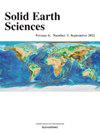根据钍钕同位素重新评估阿尔奇希卡马火山(墨西哥)的喷发历史:了解岩浆源区域对小体积火山生长的作用
IF 2
4区 地球科学
Q3 GEOSCIENCES, MULTIDISCIPLINARY
引用次数: 0
摘要
Alchichica Maar 火山位于跨墨西哥火山带的东部,火山岩从玄武岩到流纹岩,87Sr/86Sr 和 143Nd/144Nd 值分别介于 0.70293 至 0.70447 之间(εSr = -21.1 至 -4.5)和 0.512733 至 0.512949 之间(εNd = +3.4 至 +6.2)。本研究提供了组成阿尔奇希卡马火山的熔岩流、灼烧锥和岩浆沉积物的钕和锶同位素数据以及新的主要和微量元素组成。这些结果与已公布的数据相结合,重新审视了火山的喷发历史,尽管它是由一次以上的喷发事件形成的。研究了这些矿床喷发所产生的岩浆的成因,以推断深部岩浆源区域和岩浆后变化对阿尔奇希卡火山岩浆系统的形成所起的作用。Alchichica 样品的 87Sr/86Sr 值介于 0.70387 和 0.70447 之间(εSr = -9.0 至 -0.4),143Nd/144Nd 值介于 0.512749 和 0.512773 之间(εNd = +2.0 至 +2.8)。虽然 87Sr/86Sr 值表明,从岩浆喷发前的下部熔岩流到岩浆喷发的上部,放射性 87Sr 值略有增加,这表明岩浆在上地壳内受到污染,并在岩浆喷发阶段通过水动力混合而受到污染、钕同位素的微小差异表明,岩浆源总体上是均质的,小批岩浆偶发形成,为单源喷发提供了养分,随后产生了玛珥前熔岩流、玛珥前涌流、焦岩锥和玛珥单元。这项研究加强了这样一种观点,即已经 "挖掘 "过的单源火山源区可能会再次变得肥沃,新的喷发可能会从附近或旧的喷口地点发生。它还突出了小体积火山的危险潜力。本文章由计算机程序翻译,如有差异,请以英文原文为准。
Reappraising the eruptive history of the Alchichica Maar Volcano (Mexico) based on Sr–Nd isotopes: Understanding the role of the magma source region on the growth of small-volume volcanoes
Alchichica Maar is in the eastern sector of the Trans-Mexican Volcanic Belt, where volcanics range from basalts to rhyolites, with 87Sr/86Sr and 143Nd/144Nd values between 0.70293 to 0.70447 (εSr = −21.1 to −4.5) and 0.512733 to 0.512949 (εNd = +3.4 to +6.2), respectively. In this study, Nd and Sr isotopic data and new major and trace elements compositions are provided for the lava flow, the scoria cone, and the phreatomagmatic deposits composing Alchichica Maar Volcano. These results are used in combination with published data to reexamine its eruptive history, though to be formed by more than one eruptive event. The cogeneticy of the magmas that fed the eruptions of these deposits is examined to infer the role of the deep magma source region and post-magmatic alterations on the construction of the Alchichica Maar magmatic system. Alchichica samples present 87Sr/86Sr values between 0.70387 and 0.70447 (εSr = −9.0 to −0.4) and 143Nd/144Nd values from 0.512749 to 0.512773 (εNd = +2.0 to +2.8). While the 87Sr/86Sr values suggest a slight increment in radiogenic 87Sr from the pre-maar lower lava flow to the upper maar eruptions indicative of magma contamination within the upper crust and by hydrodynamic mingling during the phreatomagmatic phases, the slight variation in Nd isotopes suggest an overall homogeneous source where small batches of magmas formed episodically to feed monogenetic eruptions, which subsequently yielded the pre-maar lava flow, the pre-maar surge, the scoria cone, and the maar units. This study reinforces the idea that an already “tapped” source region of a monogenetic volcano may become fertile again, and new eruptions can occur from near or old vent sites. It also highlights the hazardous potential of small-volume volcanoes.
求助全文
通过发布文献求助,成功后即可免费获取论文全文。
去求助
来源期刊

Solid Earth Sciences
GEOSCIENCES, MULTIDISCIPLINARY-
CiteScore
3.60
自引率
5.00%
发文量
20
审稿时长
103 days
 求助内容:
求助内容: 应助结果提醒方式:
应助结果提醒方式:


